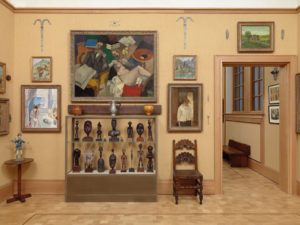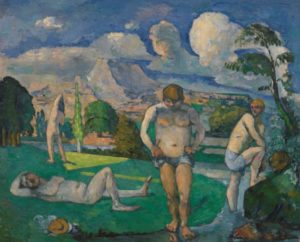The first time Roberta and I visited the Barnes Collection, we could tell why it was world-famous. The museum was at that time in its old digs in Merion, Pennsylvania, and they didn’t make a visit easy. This quiet suburb of Philadelphia did not want a lot of traffic, so admission was strictly controlled. You had to make your reservation for a visit some time in advance.
Once inside, however, you were treated to an incredible array of paintings by the greatest of the French Post-Impressionist and modernist artists – Cezanne, Seurat, Picasso, Matisse, and more, all represented by true masterpieces. They were laid out on the walls with folk art and decorative objects in the idiosyncratic hanging prescribed by Albert Barnes, the museum’s famously irascible founder.

I didn’t mind the installation, but the lighting was terrible, especially for someone accustomed to the track lighting found in modern museums and commercial galleries. Whole rooms were lit by only a single lamp in the middle of the ceiling, and the colors of many paintings seemed muted instead of being vibrant as they ought.
Barnes intended his collection to remain ensconced in Merion until Doomsday. 40 years after his death, however, the trustees found themselves facing major financial difficulties. A suggestion was made to move the collection into Philadelphia to make it more accessible to visits by lots of people. It took years of lawsuits to break the will, but in 2012 the collection moved to a modern building on Museum Parkway, not far from the Philadelphia Museum of Art.
I was excited when the new museum opened. I had heard that the foundation honored Barnes’s intention by recreating the rooms as he had laid them out in the old building, but I assumed that the works would finally get the lighting they deserved. Imagine my surprise when I visited the new building and found that, along with recreating the old rooms, the trustees had recreated the lighting as well! There were the masterpieces, struggling in the same inadequate light. Their predicament was brought home to me as I stood in front of Cezanne’s Bathers at Rest from 1876-77.

The painting hangs on a wall facing large windows. Floor to ceiling curtains normally block out the daylight, but on the day I visited, there was a six-inch gap between two of the curtains, and a narrow swath of sunlight fell directly down the middle of the painting. The difference in the green of the grass in the sunlit and the ceiling-lit portions of the painting was startling. The former made you feel that you were in the south of France, a true visual delight.
I’m not saying you should hang your paintings in direct sunlight, but bright ambient light won’t hurt them. (I’m talking oils here; works on paper, even if framed behind UV-blocking museum glass, should have a lower light level.) Why have something that you can’t really see? Let the colors sing!
When I worked for Ira Spanierman 35 years ago, it was still a time in which people walked in off the street with old paintings they wanted to sell. At first, I always took such people into the viewing room and put their painting on the easel. I soon learned that that wasn’t altogether wise. Seen under really good light, the paintings revealed themselves in a way that their owners hadn’t seen when the works were hanging in a dark parlor. Even beneath varnish that had darkened over the years, under spotlights the colors popped, and details came into focus. At worst, the owners might decide that they didn’t want to sell the paintings after all, but in any case, the asking price was liable to go up.
I realize that, short of a major remodeling job to install modern lighting, it isn’t always possible to light your paintings to a museum standard (I mean, a non-Barnes museum standard), but things can often be done. I can advise you on ways to display your collection to best advantage. Let’s talk.

